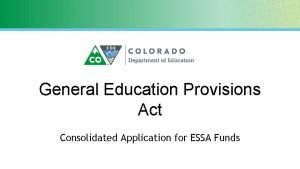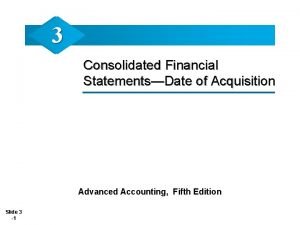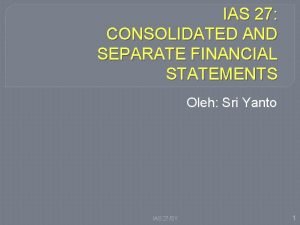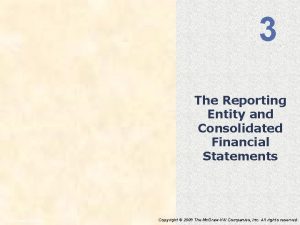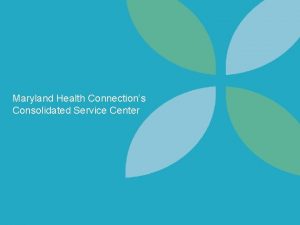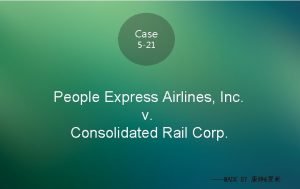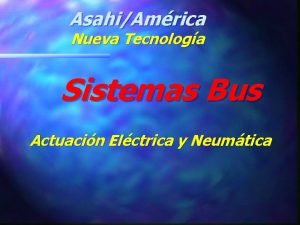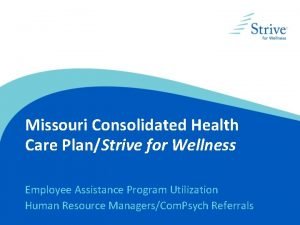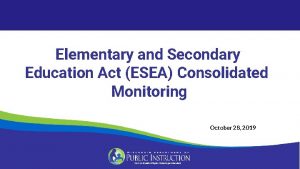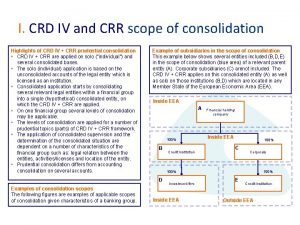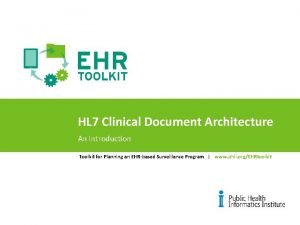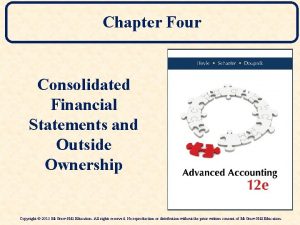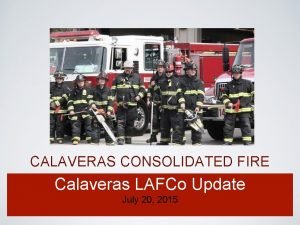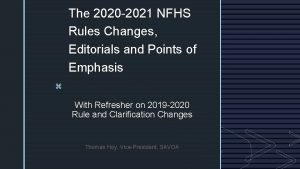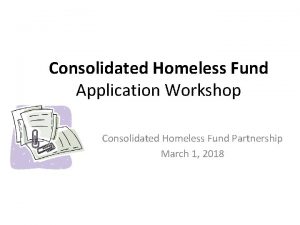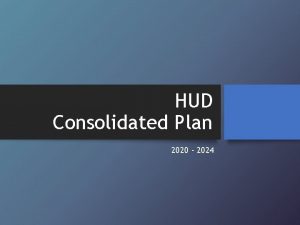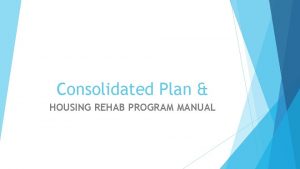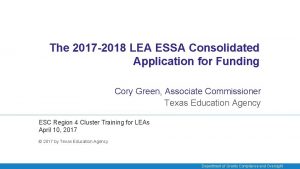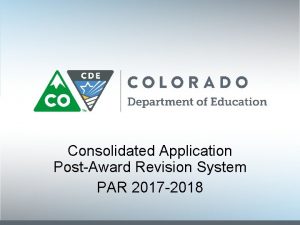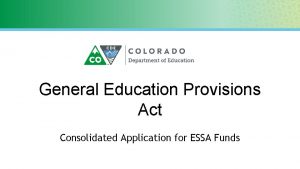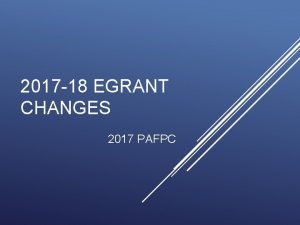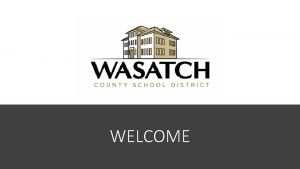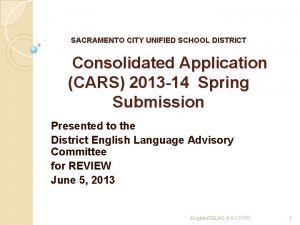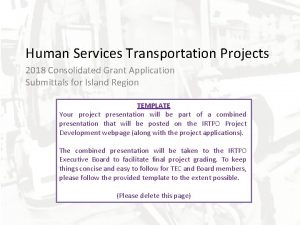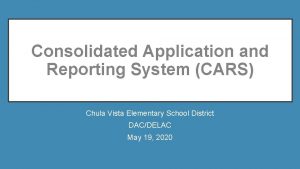2020 2021 Consolidated Application 2020 2021 Consolidated Application






























- Slides: 30

2020 -2021 Consolidated Application 2020 2021 Consolidated Application Functionality 1

Cross Program Questions 2

Purpose of Cross Program Questions To minimize what is asked of LEAs in the individual program narrative sections and to leverage the efforts of LEAs in allocating ESEA funds, CDE has developed Cross Program Questions that must be answered by all LEAs that accept ESEA funds. Cross program questions provide opportunities for LEAs to address work that spans various ESEA programs and synthesize responses. 3

Considerations for Cross Program Responses a. Can the response be derived from the UIP Executive Summary or other UIP section or another source for determining needs? e. Has the LEA considered and briefly described how supports and services will be leveraged with other state, local, and federal programs? b. Has the LEA summarized data that was reviewed, the f. Does the school or district develop a theory of action or use a frequency of the review, and included disaggregated similar process to explore and describe how the proposed data for subgroups (as relevant)? supports and services will accelerate progress toward grade level standards? Has “success” been defined? c. Are relevant stakeholder groups (that reflect the demographics of the school or district) required to be engaged in the decision making process and prioritization of needs and selected strategies? g. Should the response be limited to a point in time, or is this a continuing process? d. Does the district provide guidance, support, and h. Are budget components developed for items that cross systemic processes to support identifying, prioritizing, program needs? progress monitoring, modifying, and evaluating funded activities and programs? 4

Cross Program Question 1. 1 - Identifying Needs What process did the LEA use to identify the LEAs needs? • Check all that apply: • UIP • Strategic Plan • 90 Day Plan • Other (please describe): Approval Criteria Applicant has checked a box; if indicating “Other” the LEA has described the process used to identify LEA needs that will inform supports provided to schools 5

Cross Program Question 1. 2 - Identifying Needs How are you using the processes identified above (Q 1. 1) to identify the supports that will be provided to schools? Examples: • The districts leans on the UIP process and stakeholder feedback to identify Priority Performance Challenges and develop Major Improvement Strategies that address district wide needs at schools. • 90 Day Plans at individual schools are reviewed by Professional Learning Coordinator for commonalities that may be addressed through district level PD opportunities. Approval Criteria Response includes: • How the process identified in Q 1. 1 is used to identify LEA needs that will inform providing support to schools 6

Cross Program Question 1. 3 - Identifying Needs How do identified needs inform decisions related to ESEA programs and how frequently is the data reviewed and evaluated? Example: • The district uses the UIP process including analyses of demographic data, staff/student/family perception data, student growth/achievement data, school/district systems reviews, behavior and attendance data, and educator effectiveness data to engage stakeholders and solicit feedback in identifying Priority Performance Challenges and development of Major Improvement Strategies that address district wide and school needs on an annual basis. Benchmark data is reviewed according to the schedule set out in the UIP. Approval Criteria Response includes: • How LEA needs are used in decision making processes for ESEA programs • How often the LEA is reviewing and evaluating needs 7

Cross Program Question 2. 1 - ESEA Priorities Based on the needs assessment or LEA major improvement strategies, describe notable trends and needs identified by the LEA as top priorities for ESEA programs. Example: • Notable trend in continued low scores in K 2 reading assessment data, based on 3 years of local assessment data • Notable trend in lack of parent engagement in Title I schools, based on surveys and attendance at engagement opportunities. • Notable trend in decreasing scores in math for grades 4 6, based on 3 years of CMAS data • The district has prioritized K 2 reading and parent engagement in TI schools based on stakeholder input during the UIP development process. Approval Criteria Response includes: • A description of notable trends • The prioritized needs for ESEA programs as identified by the district 8

Cross Program Question 2. 2 - ESEA Priorities How do ESEA program priorities align with and/or supplement LEA major improvement strategies? Example: • The district has developed a solid and clearly defined Rt. I model in reading to support students as notated on the District UIP, Major Improvement Strategy (MIS) #1: Strengthen Tier 1 instruction within a multi tiered system of support for K 2 students in reading with special attention to ELL students and students with disabilities. Approval Criteria Response includes: • How the prioritized needs for ESEA programs support and/or enhance the improvement strategies for the district 9

Cross Program Question 3. 1 - Stakeholder Involvement How are district and building leaders, teachers, parents, and community members engaged in the process of determining the needs of the LEA and schools? What role do school and district accountability committees play in the process? Approval Criteria Response includes: • A description of how the district provides opportunities to solicit input and use feedback from stakeholders to determine needs • Stakeholders included in response: • Building leaders, teachers, parents, and community members • District Accountability Committee (DAC) • School Accountability Committees (SAC) 10

Cross Program Question 3. 1 - Stakeholder Involvement Example: • Formal and informal processes are in place to engage district and building leaders, teachers, parents, and community members in determining the needs of the LEA and the schools. Opportunities exist through participation in the DAC and SACs, collecting data via perception surveys (at schools and throughout the community), attending district and school informational meetings, Title I Parent meetings, information and feedback loops established through parent portals and on the school or district website, or at family and community engagement events. Opportunities to participate in the needs assessment or comment on the UIP on Consolidated Application are publicly advertised and posted. All opportunities for engagement have translation services available. 11

Cross Program Question 3. 1 - Stakeholder Involvement Example 2 (SAC and DAC) Example: • • 12 The district accountability committee includes district administration staff and support personnel, as well as parent and community partners that represent all demographic and disaggregated subgroups. The DAC collects, analyzes, disaggregates and disseminates student growth and achievement data three times per year, state assessment data once per year, and district and school level demographic, perception, discipline and attendance data four times per year. Their role in identifying and prioritizing needs via the UIP process is to review trend data over 3 years and provide input on the draft UIP and prioritize needs to address within the upcoming school year. The school accountability committee is comprised of school administration staff, teachers, and support personnel, as well as parent and community partners that represent all demographic and disaggregated subgroups. The SAC is responsible for reviewing state and local assessment data, behavioral data and looking at trends over at least 3 years. Their role is to provide input on the draft UIP and prioritize needs to address within the upcoming school year. • The DAC and SAC teams engage in a continuous process of data review and monitoring actions/strategies articulated in the district and school improvement plans, for the purpose of progress monitoring, revision of action plans, and adjustment of interventions.

Cross Program Question 3. 2 - LEA Stakeholder Involvement How has the LEA consulted with the stakeholders including school and district leaders, teachers, paraprofessionals, specialized instructional support personnel, charter school leaders, parents, community partners, and organizations with relevant and demonstrated expertise, as applicable, to create an ESEA Plan? Approval Criteria Response includes: • A description of how the district provides opportunities to solicit input and use feedback from stakeholders to prioritize needs and identify strategies for meeting identified needs through the ESEA plan. • Stakeholders include: • District leaders • • • 13 • Teachers, paraprofessionals, specialized instructional support personnel Charter school leaders (if applicable) Parents Community partners/organizations

Cross Program Question 3. 2 - LEA Stakeholder Involvement Example: • 14 Schools conduct data driven dialogues to analyze strengths and needs in terms of student achievement and growth, as well as non academic indicators. Priority performance challenges and related root causes are identified and prioritized, and improvement strategies are developed. Parents and community members along with teachers, paraprofessionals, and school staff serve on school accountability committees, providing input on school goals and improvement strategies. The school level analysis and planning related to the ongoing Unified Improvement Plan (UIP) process informs the district level UIP. The DAC includes parents, community members, district and school staff, and district and school administrators, charter school leaders, and community partners. The DAC reviews the SPF and DFP, along with summary of local assessment data, and provides input that informs the development of district level goals and improvement strategies. The Curriculum and Assessment team, and Instructional Leadership members consult with district leadership, including all principals and the Specialized Learning team, (including Special Education, the English Language Acquisition, Technology Support, Professional Learning, Assessment Coordinators, and Content Area Coordinators) to analyze school and district academic and non academic data to develop district level goals and improvement strategies. Disaggregated subgroup performance and growth is closely analyzed, including that of English learners, students who qualify for free and reduced lunch, minority students, and students with disabilities. In addition to conducting data driven dialogues at the school and district level, schools host community nights every fall to share performance and growth data with parents and community members and to solicit feedback for the improvement planning process.

Cross Program Question 3. 3 - LEA Stakeholder Involvement (Title III Only) Describe how the LEA will consult with relevant educators, families, and community members in developing the Title III plan. Approval Criteria Response includes: • How the district provides opportunities to solicit input and use feedback from stakeholders to develop the Title III plan • Stakeholders include: • Relevant educators working in the program • Families of students in the program • Community members that have relevant experience in serving the diversity of the community 15

Cross Program Question 3. 3 - LEA Stakeholder Involvement (Title III Only) Example: The LEA demonstrates participation, engagement, and solicitation of feedback in the development of the Title III Program plan by: • Providing opportunities for parents understand the educational process and their role in supporting student success by empowering them as academic partners and honoring their role as first and life long teachers • Consulting with and encouraging parents to have a voice in school and district planning and in the setting of objectives through participating in school and district committees and/or groups • Informing families of opportunities to provide input and recommendations on an advisory basis to school and district accountability committees and removing barriers to participation • For families with students in the ELD program, and community members with expertise in serving the diversity of the community • Providing multiple opportunities for parents and community members that do not speak English to comment or provide feedback through translated surveys, documents, interpretation services in meetings, etc. • Evidence that documents were translated that described proposed Title III activities with expected outcomes (for new activities) • Evidence that documents were translated for families with students in the ELD program that described how previous activities developed English and produced expected outcomes (for continuing activities) • For educators working in the ELD program 16 • Evidence that educators working in the ELD program had multiple opportunities to provide feedback on proposed new or continued Title III activities.

Cross Program Question 4. 1 - Family, School, Community Engagement Strategies Describe how the LEA implements effective outreach to inform Limited English Proficient Parents how they can be involved in their student's education and active participants in assisting their children to attain English proficiency, achieve at high levels within a well rounded education and meet the CAS: Approval Criteria Response includes: • A description of the district's outreach to support parents of Limited English Proficient students with meeting academic, linguistic, and well rounded educational needs • LEA has selected funding source(s) • If LEA has indicated activities described are supported with Title I, III, IV, or V ensure activities are budgeted in funding section(s) indicated 17

Cross Program Question 4. 1 - Family, School, Community Engagement Strategies Example: • The ELD and TI team designs activities, events, and opportunities to ensure access and involvement of families with Limited English Proficient students, including family/community nights, ESL classes for parents, culture and community events, and SAC. The district deploys full time interpreters, translators, family advocates, and family/school/community engagement specialists to meet the needs of all stakeholders. • Parents will be trained on use of Infinite Campus, website portals, and PBIS supports to increase communication between families and school staff and to inform families about their students’ grades and attendance. Families and community partners will engage in learning opportunities on how to support LEP students at home in utilizing ELD strategies. 18

Cross Program Question 4. 2 - Family, School, Community Engagement Strategies Describe the LEA's strategies to conduct outreach to all parents and family members and implement programs, activities and procedures for effective involvement of families: Approval Criteria Response includes: • A description of parent outreach activities for the district • LEA has selected funding source(s) • If LEA has indicated federal funds used (Title I, III, IV or IV) ensure activities described are budgeted in program indicated 19

Cross Program Question 4. 2 - Family, School, Community Engagement Strategies Example: • The district actively engages family, school and community involvement across all facets of the community. The ELD and TI team develops community surveys and based on analyses of results designs activities, events, and improvement planning opportunities to ensure access and involvement of all families and stakeholders, including family/community nights, ESL classes for parents, culture and community events, and SAC. The district also provides informational material, hard copies and electronic, in Spanish and other languages to meet the needs of all families. The district employs full time interpreters, translators, family advocates, and family/school/community engagement specialists to meet the needs of all stakeholders. Interpreters, tutors, and hardware/software/assistive technology are provided for families and students with disabilities and communication challenges. 20

Cross Program Question 5. 1 - Program Evaluation Based on the needs assessment, what are the intended goals and outcomes for ESEA programs? Approval Criteria Response includes: • A description of the prioritized strategies and intended goals and outcomes for ESEA programs 21

Cross Program Question 5. 1 - Program Evaluation Example: • Through a systematic exploration of needs and existing capacity, the district has hired a 1. 0 FTE Parent Involvement Facilitator to work with Title schools and coordinate parent involvement programs at each site. The facilitator will improve the activities that encourage parent involvement in the school district as well as the school sites. • By second semester, the facilitator will establish a feedback loop between parents and the school/district • Implementation will be considered successful if 50% of parents at targeted sites have logged in and sent responses through either the web based or call in system established, as verified by data, at the end of the second semester • Parent volunteers will be recruited to make reminder phone calls at each school site • Satisfaction surveys will be developed for each parent engagement activity and will be used to inform improvements in practices and ongoing needs at impacted sites 22

Cross Program Question 5. 2 - Program Evaluation Describe how the LEA evaluates the effectiveness of programs supported by ESEA funds including what data the LEA uses to inform decisions to modify, continue, or terminate ESEA funded programs. Where decisions about these activities are made at the school level, describe how the LEA supports schools in this process. Approval Criteria Response includes: • A description of how the district evaluates programs and uses data to make decisions about the use of ESEA funds • A description of how the district supports schools in evaluating activities and programs 23

Cross Program Question 5. 2 - Program Evaluation Example 1: • The District uses a theory of action to describe how the needs identified in the CNA will be met using evidence based strategies to reach desired outcomes (along with associated performance measures) for each of the strategies implemented at schools. Benchmark data are reviewed quarterly by a variety of school and district stakeholders to ensure that implementation is on track. If it is determined that adjustments are needed in programming to meet intended outcomes, program modifications will be made as needed. • Data sets include those performance and implementation measures identified in theory of action • Relevant stakeholders are included in the process of program implementation review, at intervals specified in implementation benchmark goals • As appropriate, these stakeholders are involved in ongoing decision making, however, school and district leadership have the authority to collaboratively modify or adjust programming 24

Cross Program Question 5. 2 - Program Evaluation Example 2: • Every fall, the district collects a wide range of performance data to create an annual comprehensive needs assessment. This data is presented to the board and includes information concerning a wide variety of student groups such as ELL, G/T, MTSS, students with disabilities, Title, FRL, and minority students. This information is then compared to last year’s UIP CNA and improvement plan. At this time, if the data demonstrates differences in our needs and actions based on those needs, we will update the UIP to include needed steps for academic improvement—responding to current needs of students. In the spring, data is again collected and presented to stakeholder groups to evaluate the progress of students. Our UIP for the following year emerges as a result of this process and adjustments are made as needed. The data that are collected ranges from DIBELS data, NWEA, state assessment, perception data from families, attendance, discipline data, SEL survey results, as well as staff input. This process allows the district to quickly identify needs and implement a shift our services. An illustration of this tactic involved a change in our intervention process based on the information collected. Data verified that students were still not making progress. A group of teachers convened to investigate the "why, ” and determined the interventions were not carried out with fidelity and students were receiving a patchwork of interventions that at times were not matched to their deficiency. The team began reinventing end of day intervention groups so that they were targeted towards a wide variety of identified gaps. Currently, students with identified gaps are placed in a time bound intervention group for a specific task to mitigate the gap and progress is evaluated at the end of the period before moving on to another group, if they have made adequate progress. This process should provide more information that will help determine the impact of programming to assist students in closing the achievement gap. 25

Cross Program Question 5. 2 - Program Evaluation, District Support Example: • The District provides training on using various tools to align the school needs with the most favorable evidence based practices or resources that meet critical alignment markers to local capacity and fit. The district encourages using a theory of action or similar process when determining the needs, in selecting evidence based strategies, and articulating desired outcomes (along with associated performance measures) for each of the proposed strategies to be implemented at schools. Data dives are facilitated within bi weekly PLCs, based on district designed protocols. School administrators, content teachers, support personnel, and instructional paraprofessionals participate in these PLCs. 26

Questions? ?

ESEA Office Position Phone E-mail Nazie Mohajeri Nelson Director of ESEA Office 303 866 6205 Mohajeri nelson_n@cde. state. co. us De. Lilah Collins Assistant Director of ESEA Office 303 866 6850 Collins_d@cde. state. co. us Michelle Prael Program Support 303 866 6998 prael_m@cde. state. co. us ESEA Team Region & Program Expertise Phone Brad Bylsma Director of Support Coordinators Kristen Collins Northwest & West Central, Title V and Stakeholder Involvement 303 866 6705 collins_k@cde. state. co. us Tammy Giessinger Pikes Peak & Southeast, Title IV and School Improvement 303 866 6992 giessinger_t@cde. state. co. us Karen Ingalls North Central & Northeast, Title I Lead 303 -866 -3897 Ingalls_k@cde. state. co. us Jeremy Meredith Southwest, Title II 303 866 3905 meredith_j@cde. state. co. us Laura Meushaw Pikes Peak & Southeast, Titles I and School Improvement 303 866 6618 meushaw_l@cde. state. co. us Robert Thompson Northwest & West Central, Title III 303 866 6842 thompson_r@cde. state. co. us Barb Vassis North Central & Northeast, Titles I and II 303 866 6065 vassis_b@cde. state. co. us Joey Willett Southwest, Titles I and ID, Monitoring 303 866 6700 willett_j@cde. state. co. us 28 303 866 6937 E-mail bylsma_b@cde. state. co. us

ESEA Office (Cont. ) ESEA Office Position Phone E-mail Nazie Mohajeri Nelson Director of ESEA Office 303 866 6205 Mohajeri nelson_n@cde. state. co. us De. Lilah Collins Asst. Director of ESEA Office 303 866 6850 Collins_d@cde. state. co. us CGA Team Program Expertise Phone E-mail Kim Burnham Competitive, Grants & Awards Supervisor 303 866 6916 Burnham_K@cde. state. co. us Patricia Gleason Senior Consultant, Grants & Awards 303 866 6143 Gleason_P@cde. state. co. us Mandy Christensen Senior Consultant, Grants & Awards 303 866 6250 Christensen_m@cde. state. co. us Brittany Jimenez Program Support 303 866 6813 Jimenez_B@cde. state. co. us DARE Team Expertise Phone Email Tina Negley ESSA Accountability, Program Evaluation, and Reporting 303 866 5243 negley_t@cde. state. co. us Alan Shimmin ESEA Reporting and Data Collections 303 866 6209 shimmin_a@cde. state. co. us Mary Shen ESEA Program Evaluation, Research, and Accountability 303 866 4571 shen_m@cde. state. co. us 29

Grants Fiscal Contacts Grants Fiscal Staff Program Expertise Phone E-mail Jennifer Austin Director of Grants Fiscal 303 866 6689 Austin_j@cde. state. co. us Robert Hawkins Grants Fiscal Analyst 303 866 6775 Hawkins_r@cde. state. co. us Steven Kaleda Grants Fiscal Analyst 303 866 6724 kaleda_s@cde. state. co. us 30
 Allowable bearing capacity
Allowable bearing capacity Gepa statement examples
Gepa statement examples Consolidated shipping services
Consolidated shipping services Grant hatlen south africa
Grant hatlen south africa Subsidiary company meaning
Subsidiary company meaning Consolidated financial statements date of acquisition
Consolidated financial statements date of acquisition Ias 27
Ias 27 Vertical
Vertical A consolidated entity is:
A consolidated entity is: Consolidated companies are different sap
Consolidated companies are different sap Noc saga consolidated
Noc saga consolidated Consolidated service center
Consolidated service center People express airlines v consolidated rail corp
People express airlines v consolidated rail corp Abitibi consolidated
Abitibi consolidated My mchcp
My mchcp Consolidated companies are different sap
Consolidated companies are different sap Business intelligence project plan
Business intelligence project plan Consolidated retained earnings
Consolidated retained earnings Prediction format
Prediction format Sap business one intercompany integration
Sap business one intercompany integration How to draw mohr's circle for triaxial test
How to draw mohr's circle for triaxial test Consolidated monitoring
Consolidated monitoring Crd consolidated
Crd consolidated Clinical document architecture
Clinical document architecture Aquifer
Aquifer Consolidated trust
Consolidated trust Consolidated financial statements and outside ownership
Consolidated financial statements and outside ownership Calaveras consolidated fire
Calaveras consolidated fire Consolidated business plan
Consolidated business plan Teacher goals for 2020-2021
Teacher goals for 2020-2021 Nfhs volleyball uniform rules 2020-2021
Nfhs volleyball uniform rules 2020-2021

